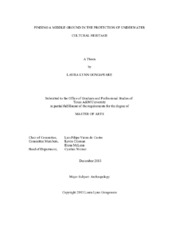| dc.description.abstract | The 2001 UNESCO Convention on the Protection of the Underwater Cultural Heritage bans the commercial exploitation of underwater cultural heritage. Despite this ban, “commercial exploitation” is not formally defined in the Convention and the only legally binding guidance on what constitutes commercial exploitation is the two exceptions to commercial exploitation in rule 2 of the Annex Rules to the Convention. As a result, the determination of whether underwater cultural heritage has been commercially exploited must be made on a case-by-case basis. The inquiry is of particular importance because the Convention also indirectly bans exhibitions of commercially exploited underwater cultural heritage.
The salvage of the Belitung shipwreck and the ensuing controversy over the exhibition of the Belitung artifact collection provides an instructive analysis of the Convention’s ban on commercial exploitation. Seabed Explorations, a commercial salvage company, contracted with the government of Indonesia to salvage the Belitung wreck, a ninth-century Arabian vessel that provides unprecedented information about the maritime component of the land-based Silk Road. Although analysis of the salvage operation establishes that the Belitung wreck was commercially exploited, there is much about the Belitung wreck that suggests that an outright ban on its exhibition and study would violate the spirit of the Convention.
The salvage of RMS TITANIC provides another interesting case study, particularly as it applies to article 4’s limitation on the application of the law of salvage and law of finds. Both the law of salvage and the law of finds are inherently commercial in nature, and as such, many believe that the law of salvage and law of finds should not be applied to underwater cultural heritage. The salvage of TITANIC establishes that salvage does not result in per se commercial exploitation and that courts can apply the law of salvage in a way that ensures protection.
Although the ban on commercial exploitation is an important part of the 2001 UNESCO Convention, the Belitung wreck and TITANIC prove that a ban on commercially exploited underwater cultural heritage, or heritage believed-to-be commercially exploited, violates the spirit of the Convention, because such a ban does not take into account what is best for the resource itself. A middle ground must be reached through a less conservative reading of the Convention. | en |


